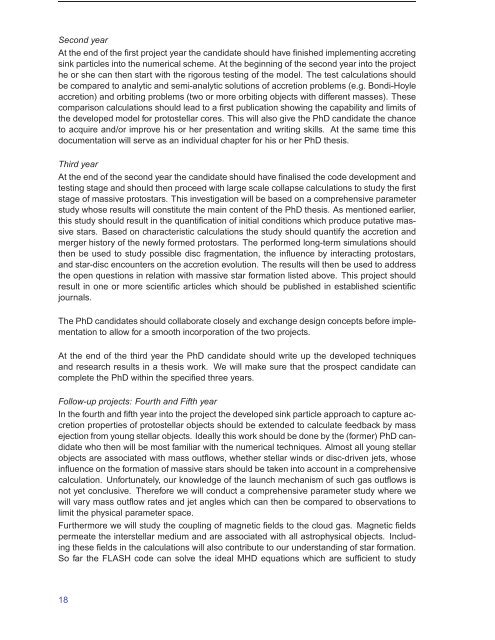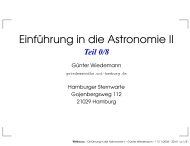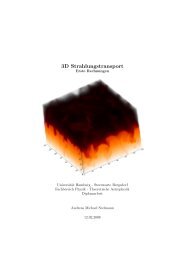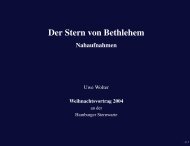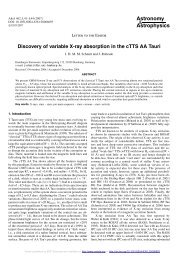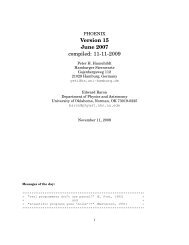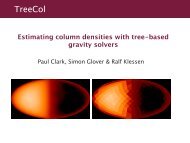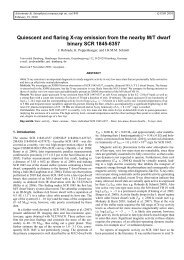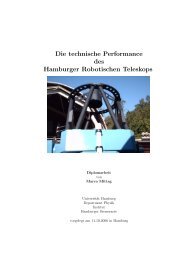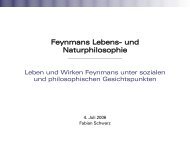Emmy Noether Application
Emmy Noether Application
Emmy Noether Application
You also want an ePaper? Increase the reach of your titles
YUMPU automatically turns print PDFs into web optimized ePapers that Google loves.
Second year<br />
At the end of the first project year the candidate should have finished implementing accreting<br />
sink particles into the numerical scheme. At the beginning of the second year into the project<br />
he or she can then start with the rigorous testing of the model. The test calculations should<br />
be compared to analytic and semi-analytic solutions of accretion problems (e.g. Bondi-Hoyle<br />
accretion) and orbiting problems (two or more orbiting objects with different masses). These<br />
comparison calculations should lead to a first publication showing the capability and limits of<br />
the developed model for protostellar cores. This will also give the PhD candidate the chance<br />
to acquire and/or improve his or her presentation and writing skills. At the same time this<br />
documentation will serve as an individual chapter for his or her PhD thesis.<br />
Third year<br />
At the end of the second year the candidate should have finalised the code development and<br />
testing stage and should then proceed with large scale collapse calculations to study the first<br />
stage of massive protostars. This investigation will be based on a comprehensive parameter<br />
study whose results will constitute the main content of the PhD thesis. As mentioned earlier,<br />
this study should result in the quantification of initial conditions which produce putative massive<br />
stars. Based on characteristic calculations the study should quantify the accretion and<br />
merger history of the newly formed protostars. The performed long-term simulations should<br />
then be used to study possible disc fragmentation, the influence by interacting protostars,<br />
and star-disc encounters on the accretion evolution. The results will then be used to address<br />
the open questions in relation with massive star formation listed above. This project should<br />
result in one or more scientific articles which should be published in established scientific<br />
journals.<br />
The PhD candidates should collaborate closely and exchange design concepts before implementation<br />
to allow for a smooth incorporation of the two projects.<br />
At the end of the third year the PhD candidate should write up the developed techniques<br />
and research results in a thesis work. We will make sure that the prospect candidate can<br />
complete the PhD within the specified three years.<br />
Follow-up projects: Fourth and Fifth year<br />
In the fourth and fifth year into the project the developed sink particle approach to capture accretion<br />
properties of protostellar objects should be extended to calculate feedback by mass<br />
ejection from young stellar objects. Ideally this work should be done by the (former) PhD candidate<br />
who then will be most familiar with the numerical techniques. Almost all young stellar<br />
objects are associated with mass outflows, whether stellar winds or disc-driven jets, whose<br />
influence on the formation of massive stars should be taken into account in a comprehensive<br />
calculation. Unfortunately, our knowledge of the launch mechanism of such gas outflows is<br />
not yet conclusive. Therefore we will conduct a comprehensive parameter study where we<br />
will vary mass outflow rates and jet angles which can then be compared to observations to<br />
limit the physical parameter space.<br />
Furthermore we will study the coupling of magnetic fields to the cloud gas. Magnetic fields<br />
permeate the interstellar medium and are associated with all astrophysical objects. Including<br />
these fields in the calculations will also contribute to our understanding of star formation.<br />
So far the FLASH code can solve the ideal MHD equations which are sufficient to study<br />
18


